Archive for category Uncategorized
Dexter’s Laboratory took a simple phrase, and trope, to its logically dark conclusion
Posted by kjohnson1585 in Animation, Animation Breakdown, Television, Uncategorized, Writing on August 4, 2017
Dexter’s Laboratory (S1E9) – Doll House Drama… by ClassicCartoonChannel
Dexter’s Laboratory staked its claim in the animation landscape with one simple phrase. It wasn’t a meaningful phrase, and by itself, it wasn’t particularly funny. It’s a phrase that’s pretty innocuous, a nothing of a phrase that nevertheless feels like the culmination of everything the show was trying (and managed) to be. That phrase, you may have guessed, is cheese omelet, or as you would say in French: “omelette du fromage.”
Dexter’s Laboratory is perhaps one of the most important cartoons of the mid 90s, a bold, stark, animated show defined by the direct, specific use of simple shapes, harsh editing, and dramatic visual irony. It’s a show comfortable with a certain “throwaway approach” to character design consistency: characters could change size, even shape, as long as the gags would hit, and hit hard. Dexter’s lab itself always changed, never once looking the same from episode to episode – even how you entered the lab changed through the series (shades of the various, comical ways Perry the Platypus would enter his own underground hideout in Phineas and Ferb). Most animated shows in the post-Dexter’s Laboratory world will mimic or copy the look but not the style, and certainly not the subject, creating a lot of basic, sharp-angled, sloppy shows that more or less were done as a cost-cutting maneuver. Dexter’s Laboratory was (one of the) first, and Genndy Tartakovsky honed his skills here, sharping his timing, pacing, and framing to create iconic sensibilities in the more critically-known Samurai Jack.
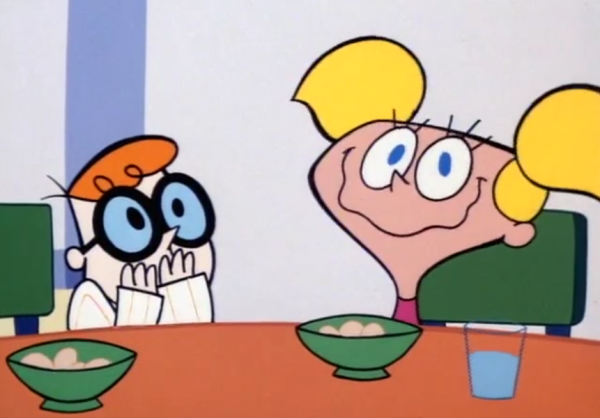
We cannot dismiss what Dexter’s Laboratory was doing when hit CN all those years ago. It’s difficult to think about it now, with so many cartoons on the air these days, but even back then the show was playing smart and coy with what kids animation was doing, and could do. It played into a lot of animation tropes, both Western and Eastern, only to undercut them with a narrative twist, a comically sudden beat, or with something so average, so anti-climatic, that you found yourself wondering if you somehow missed the actual ending. Even back then, cartoons were doing some interesting and crazy things, mostly in terms of narrative commitment, but Dexter’s Laboratory looked backwards towards classic cartoon formatting and style for inspiration. Episodes will be split between several shorts, most about Dexter and his family, but other character and show types, including “The Justice Friends” and “Dial M for Monkey.” The rhythms of the entire show will move somewhat like Rocky & Bullwinkle, an assortment of short animated bits, a format mimicked and copied all throughout the Hanna-Barbera era.
Watching the entire episode – which includes “Doll House Drama,” “Krunk’s Date,” and a brief sequence parodying comic book ads disguised as actual comics – I’m struck by the degree in which Dexter’s Laboratory really engages in that classic format. Not just in the ideas of each episode, but even in the stunted movements and somewhat off-kilter edits. The rhythms would definitely be familiar to those who grew up watching something like The Banana Splits or Yogi’s Gang. “Krunk’s Date,” in particular, utilizes a lazy, “limited laugh track” to ostensibly shore up the comedy, but is obviously used ironically here. Dexter’s Laboratory is more committed to its comic beats here than those shows would ever be, and those first two episodes ends on somewhat odd, downbeat gags that feel different than the “sad trombone” gags of its predecessors.
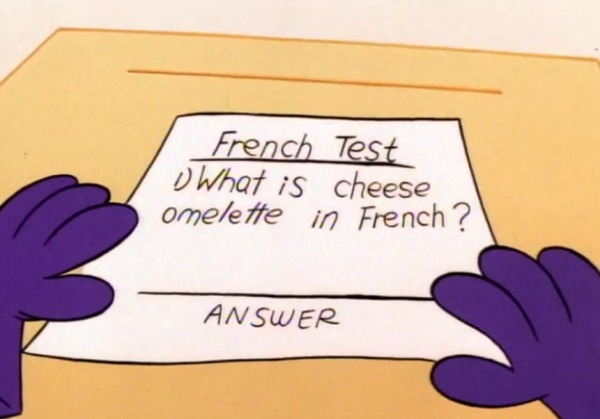
Then we get to “The Big Cheese,” an episode that hilariously steers into its one-note gag to an insane degree – only to snatch it away, hard and without warning. Rewatching this episode, I’m also struck with how patient Tartakovsky builds the gag. Dexter puts off his French homework to work on other, “more important” scientific pursuits, although some are really generic chores with complicated names. There’s no “panic” when Dexter realizes he still has to study – he just decides on a fairly normal trope – overnight osmosis. Playing a record that pipes French-lessons into his ears while he sleeps, the record skips over and over when it hits one central phrase: omelette du fromage. By the 90s, we were well in the CD/cassette era, so Dexter using a record for this feels silly, but it is central to the joke, and Dexter has been shown to disregard a lot of basic ideas for the pursuit of higher intelligence. Obviously his arrogance will prove to be his downfall, but “The Big Cheese’s” idea of a downfall is brutal.
Tartakovsky is fully aware of the trope in play, in how most shows would have its main character work around his situation to avoid being caught in one-phras-only mode. So Tarakovsky immediately has Dexter get caught. It’s by his sister, Dee-Dee, and she begins a comic repetition of her own: “That’s all you can say!” she sing-shouts, over and over, and at this point, it’s amusing. There is also a forewarning nature to it, specifically when she pops up during the montage, a sign of bad things to come. But before that point, that montage is a doozy. Montages are a dime a dozen in cartoons, but here, Tartakovsky escalates the absurdity of the situation with some impressive decision. He even starts the absurdity with a test with one single question, then ramps things up in more and more ridiculous ways. Some are a bit obvious, like omelette du fromage being a French town somehow, and the girls in the class being smitten by his use of French. The potential bullies suddenly being scared off by Dexter’s use of the phrase, however, is such a random development, precisely because unlike the previous gags, this one completely lacks any reason to have occurred.
The combination of “maybe this could happen?” and “no way this could happen” results fill up the rest of the montage. Dexter brings world peace. He becomes TIMES Man of the Year. Parades are thrown in his honor. He has a number one hit song that’s composed of, one assumes, just that phrase. It’s so dumb, but there’s a perverse comic value in seeing all the ways Tartakovsky takes this singular bit, pushing and pushing and pushing it to hilarious lengths. And it’s all pretty fantastic… up until the final moments. (I do want to point out that before Dexter enters his home, he kisses a baby, then drops it, as cameras flash. I feel like that’s a key visual sign for the next scene, but I think I’m really over-reading what amounts to a simple, hilarious joke-within-a-joke).
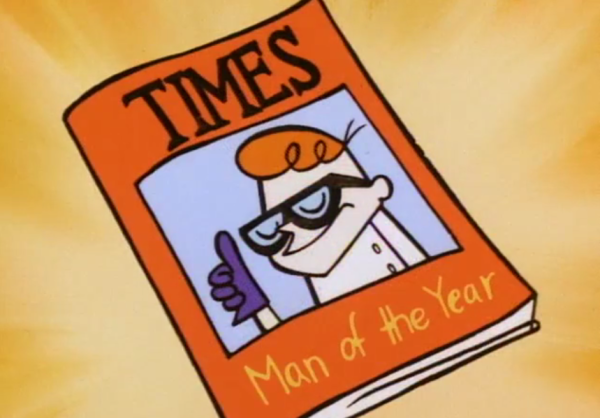
It’s in those final moments though that things turn against Dexter – the karmic, schadenfreude moment that takes thing perhaps too far. Outside his lab, the young scientist learns that his solitary word usage isn’t the password to enter his lab. His computer not only locks the lab up tighter, it begins a self-destruct sequence. Dexter, panicking and in literal tears, shouts in desperation, but only “omelette du fromage” can escape his lips. And then his sister pops up. She begins reciting in comically dark fashion the very phrase she’s been repeating all day, “That’s all you can say.” Unhelpful and useless. And if you were expecting a saving grace, a final reprieve that saves Dexter’s lab and allows the child to learn a lesson in the relative clear… it does not come. The computer says “one.” The lab completely explodes. Dexter and Dee-Dee are visible through a massive hole in their house. Fade to black. THE END pop on screen, “That’s all you can say” echoing silently in the background.
It’s pretty ridiculous in a sense. It’s a cartoon, and developing sympathy for Dexter and his lab, particularly after an episode where he skates by on a French phrase through success after success, comes across as a little weird. Dexter doesn’t really hurt anyone (except that baby, which maybe is worth discussing), and other than his hubris, there’s the question of whether the karmic destruction of his life’s work is proportional punishment to his behavior. It really isn’t his fault that he got famous off the phrase. There’s a lot to be said about the public’s infatuation over such a dumb, singular concept – and I should remind you that this episode took places years before social media and “going viral” was a thing. [I really want to do a piece about how cartoons portray crowds and public reactions; there’s a difference between mob mentality and blindly following a large group for gag purposes.] This is reminiscent of The Simpsons’ “Bart Gets Famous,” in which Bart experiences the highs and lows of success brought about by his own oft-repeated motto “I didn’t do it,” but that show had the time to draw into the reluctance and complexity of Bart’s feelings towards his entire “fifteen minutes.” With “The Big Cheese,” Tartakovsky had three minutes to get to his point, and he focused on the perfect visual display of the rise and fall of success – the fall embodied in a dark, destructive moment that shocked a young generation.
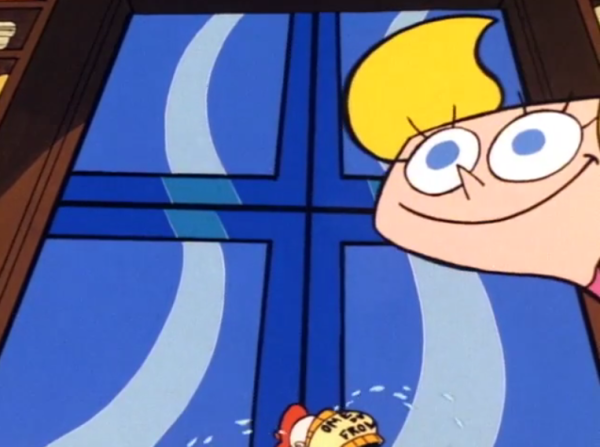
Perhaps “proportional punishment” isn’t really a thing. Sometimes you find yourself so caught up in something that you fail to realize how far you are from the things you once held dear – and they’re gone in an instant. Tartakovsky made his point clear, and it left many people with only “omelette du fromage” and “that’s all you can say” dancing in their heads, in the midst of a dark, music-less void. The very premise of the show, Dexter’s Laboratory, was gone in an instant, leaving kids to wonder if, and why, such a bleakness was warranted. As an adult, we wonder about it still.
NEXT: Rescue Rangers’ uses a badass Gadget Hackwrench to contemplate the value of religion in “The Case of the Cola Cult.”
Niko and the Sword of Light Proves Adventure Tales Still Have Merit
Posted by kjohnson1585 in Animation, Television, Uncategorized, Video Games, Writing on August 2, 2017
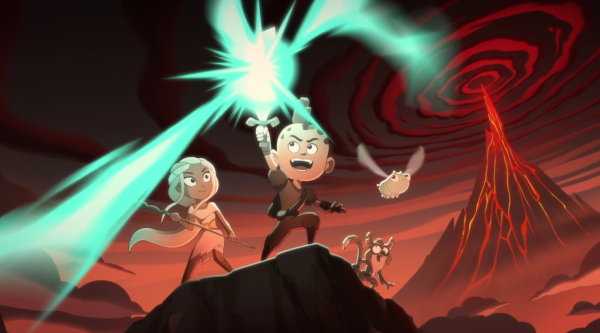
Niko and his party (which include Princess Lyra, Mandok, and Flicker) run into a stranger in the middle of the first season of Niko and the Sword of Light. The stranger is a talented, effective fighter, a rogue-type mercenary, and he proves to be a better warrior than Mandok. So of course, Niko and Lyra heap praise on this stranger while Mandok stews in jealousy. This stranger makes an important and needed contribution to the team. Every time you think he’ll betray everyone, it turns out to be a red herring. Lulls viewers into a certain set of expectations. But we’re adults, and we’ve seen these kinds of long-term adventure tales before: Lord of the Rings, The Last Airbender, hell, even The Matrix. We know that this stranger will indeed turn out to be a traitor, right as the team is at its most vulnerable. We see it coming, but even still, it’s a striking moment.
It’s a simple moment, too: it’s devoid of any massive complication or overwrought details. There’s depth to the characters, and the world they inhabit, but that depth is important insomuch as it simply provides obstacles and/or methods to overcome them. In other words, don’t expect to delve deep into lore or culture in your fan theories or thinkpieces. But what this does prove is that the basic storytelling tropes of these large, globe-trotting adventure tales can still be effective and powerful and entertaining, especially to younger kids who are new to these kinds of tales. We often forget that there’s an entire demo that hasn’t seen, watched or read these kinds of stories, so they don’t know how to look for the tell-tale signs of betrayal, or homages to Westerns or horror tropes, or the various ways high-end fantasy portrays itself. The twists are obvious but still work, and it helps that the animation is gorgeous, with big, expansive backgrounds and some of the tightest, sharpest action sequences since The Legend of Korra. All to get you into a story that we have witnessed time and time again.
The core of such a story is still engaging though, and Niko and the Sword of Light commits to it in ways that keep it fun and light AND dark and mysterious at the same time. It keeps things moving, a consistent story that manages to keep up along thirteen entire episodes, finding small twists and story beats to maintain that momentum. To be clear, those twists and beats aren’t anything new – besides the aforementioned obvious traitor, there’s the “flawed former hero,” a rally-the-troops moment, temptations galore, and many, many low points before they become inspirationally high. Discerning viewers already on the fence about watching a low-key adventure tale may also be bothered by the show’s humor, which isn’t childish per se, but it is rather basic and simplistic, and at its worst, forced into moments where the dramatic tension is thusly ruined. But there’s a reason these adventure tales are told so often: the wonder, magic, mystery, and action still can delight an audience.
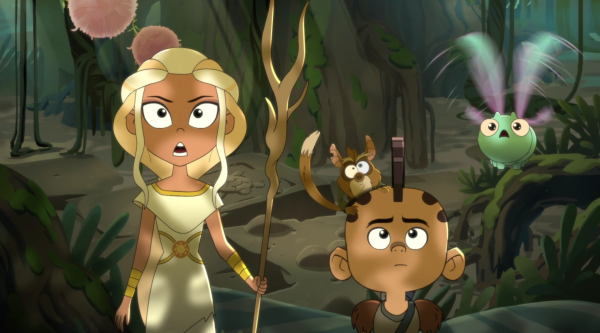
The highest point of the show is its action scenes. Dynamic, vibrant, and engaging, Titmouse has always excelled at crisp, clear, and exciting action, and they bring it to the table here. Watching Niko and Lyra do battle with huge, grotesque monsters is a treat, and it’s both amusing and impressive to watch a ten-year old boy move like a skilled gymnast warrior to dodge massive tentacles or flailing tails. And as great as the monster battles are, the show’s most rewarding fight takes place in episode nine, “From the Cliffs of Catastrophe to the Pools of Destiny” (every location is named in such a fashion, and the show more or less lampshades this convention in many scenes in which characters spout out a series of locales with similar names). Not to spoil too much, but the action here is absolutely wild, arguably the best balls-out battle since the final episode of The Last Airbender. I should also mention that, in a way that’s kind of hard to describe, the action scenes feel very much like you’re actually playing a game – like you’re pressing the buttons to actually perform the specific combos, special “light” moves, and various slick-ass dodges you see on screen. Part of that is because, yes, Niko and the Sword of Light is based on a mobile game of the same name. But it’s also because of how specific Niko’s moveset is, how he moves in action, and how he engages in actual battle. Each swing, each attack, each shouted-out-loud special move feels like an input and has an… aesthetic tactile result and response while watching. I know that saying a show feels like a video game is often negative, but here, it’s absolutely a positive.
And even if Niko and the Sword of Light is mostly a barebones adventure tales with slightly-overwrought gags and tightly storyboard action, there is just enough backend details for those who prefer to read deeper into the world. The various characters that our heroes meet lean a bit on the silly end of their characterizations, but they still feel like a culture with a long history, like the “meercoons,” who have chronicled the failures of past champions over centuries. The central story itself, in which humanity froze itself in safety while guiding said champions over such a long history to fight the darkness, grows more unique and darker over the season, with episode four’s “From the Phantom Woods to the Mountains of Misery” an excellent portrayal of exposition. (It’s even explained why Niko himself is only ten, since the crystal from which he was born was shattered too early, but he still speaks/acts like an older hero, which explains the awkward-sounding dialogue – although I can’t say that Andre Robinson’s VO work isn’t flawless.) The monsters feel like the product of arbitrary “scary” design principles until the main villain, Nar Est, admits that his monstrous creations are just his artistic flourishes. My favorite detail occurs at the Pools of Destiny (episode nine is arguably the show’s best): vague spoilers, but the Pools aren’t what they seem, a product of hyped historical precedent.
And there’s Niko and Lyra themselves. The entire crew grows closer over the course of the adventure but there’s a clear thematic understanding that occurs between the champion and the princess, an understanding that underlies the entire season. Niko’s desire to help all the various groups of people they encounter runs counter to Lyra’s overall goal of reaching and defeating Nar Est. Centuries of failure stem from overall acts of kindness for even the smaller groups of people they meet. When Niko starts to help them, he is the first of a long line of champions to offer assistance for the common person, and it leads to some small but pronounced surprises towards the end. It’s an ending that perhaps culls too much from The Last Airbender and Legend of Korra – two obvious influences, along with Samurai Jack (Nar Est is basically Akku) – but it is satisfying nonetheless, the end result of an adventure story that excels in ways both small and large. I wish the show was deeper and, perhaps, darker, but I also worry that such a direction would force it into a “gritty, serious” state, and that is not a direction that would work for such a show. Still, a bit more depth to some of the specific characters are necessary – like the three “opposterums” whose desperation to stay as a combined, cursed monster really needed exploring – and a better control over the tonal dissonance between its dramatic and comedic moments. The core storytelling is still strong however, and adventure tales like Niko and the Sword of Light still can inspire imagination and wonder in children and adults like the various tales before it.
Some Brief Words on Penn Zero: Part-Time Hero
Posted by kjohnson1585 in Animation, Television, Uncategorized, Writing on July 28, 2017
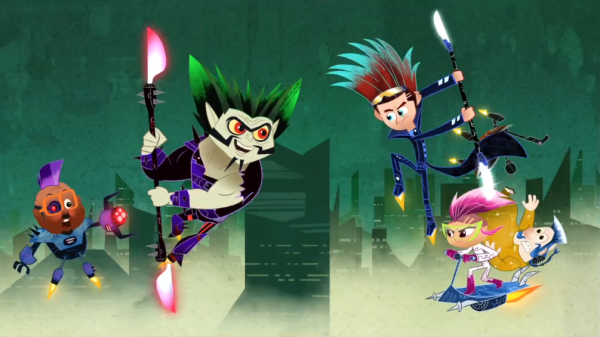
The premise of Penn Zero: Part-Time Hero doesn’t make any sense. A boy and his friends, who all still attend school, head into an abandoned theater where they are warped into alternate dimensions, take the role of some kind of protagonist/leader (and their sidekicks/lackeys), and have to accomplish some grand objective. When they do this, they (apparently?) take over the bodies of characters that already exist in that world. They also have to face a set of antagonists/villains that are controlled/taken over by their art teacher and school principal. When they return home, everything is back to the way things are – as normal as things could be. There’s a lot of questions. How did a bunch of kids get into the gig of interdimensional body-control and part-time heroics? (Penn, arguably, got into it through his parents – more on this later – but his sidekicks Sashi and Boone are occupational enigmas.) What happens to the people when they take over their bodies? What about Rippen and Larry? Who is Phyllis, the lady who controls the portal machine? What signals a particular world that needs heroics? Why would a world need competing villains? How long has all this been going on? And why?
I think that most of these questions were meant to be answered – or least explored – over the course of several seasons. It only received two. And as Penn Zero ends its two season run today, we’re given all the answers we’ll ever get (bearing an unlikely comic or graphic novel followup). In a way, it’s fine. The second season of Penn Zero did little about answering those big questions, and focused on smaller, personal bits of characterization – and exaggerated cartoon satire in the midst of broad, insanely creative alternate dimensions. The show scrambled together a brief, clearly-rushed season arc in which Penn had to find some crystal shards so Phyllis can track where his parents are (also part-time heroes), an arc that gets its due only in four of the final fourteen episodes. It spent most of its other episodes either revisiting past worlds with new, more intense objectives, or finding themselves in new locales with more ridiculous, almost nonsensical ones. Penn Zero, in its remaining season, culled together final episode pitches with an assortment of ideas that seem geared for a multiple seasons. It treated its second season as if it was its fifth season.
There’s something bold about that, though. I mean, if you’re forced to end your show a bit prematurely, you might as well throw all your best ideas out there. It may be too many ideas though. Episodes feel overrun at times, like Penn’s return to a world of dragons that, in the first season, just doubled as a Top Gun parody. The team’s second appearance incorporate elements from Star Wars, Aliens, My Little Pony, and a host of other pop culture references that I recognized. There’s also a lot of wink-winking towards animation tropes, like a hilarious anime-parody episode, a sitcom-bashing one, and one that engaged in a classic cat-and-mouse chase cartoon, similar to Tom & Jerry. Some episodes are just plan weird: the cast returns to a world where everyone is some kind of sport ball, literally, and it includes Curtis Armstrong as a super bouncy ball with serious insecurity and anger issues for some reason. An episode that checks in on Penn’s parents includes a fire-breathing giant chicken, a sketchy city inside the belly of said chicken, a sleazy pickpocket with an eyeball for a belly and lips for a head (voiced my Marc Maron), and mafioso, flamethrower-wielding grandmother with zombie cat demons for henchmen. This… is a weird show.
Speaking of which, the situation with Penn’s parents form the backbone of the show’s arc. They’re trapped in that bizarre world mentioned in the previous paragraph, and Penn has to recover three shards of… something to bring them back. It’s not exactly a tightly-scripted story arc – the retrieval of the first shard is accomplished during a weird random end tag, involving a giant Phyllis, which raises even more questions (and I know I’m skipping a lot of explanation here, but the episode has Penn deciding whether to go after the shard or save the day, and it doesn’t explain why Penn doesn’t just go after the shard after saving the day, or coming back to this world just a bit later). It does however delineate high-level stakes to these final episodes. There is pretty strong theme of loyalty, heroics, and sacrifice, especially between the roles of parental and childish figures, but fourteen episodes are not nearly enough to delve into them. Still, Penn Zero went ahead and did it anyway, which requires some balls.
You can’t help but wonder if Penn Zero: Part-Time Hero was meant to be the popular followup to Phineas and Ferb, another show that involved a weird-looking red-haired kid and random forays into strange places (that now looks to be Milo Murphy’s Law, a show that needs to explored at another time). Disney XD was going through some issues, and a lot of two season shows got shut down (including the delightful Wander Over Yonder and the not-so-delightful 7D). I don’t know if Penn Zero needed, or deserved, more time to flesh itself out. It was funny and clever enough, the characters were perfectly, comically realized (Sashi (Tani Guadi) was the overall show standout but second-season Penn (Thomas Middleditch) came up strong), and it clearly had a blast coming up with some of the alternate dimensions and the plots that took place in them. It felt like it got so caught up in that creative freeform that it never took the time it needed to really let its characters, and its specific in-world logic, explain itself.
That’s not necessarily bad. Lots of shows don’t make sense and thrive on that concept: Archer is purposely anachronistic, and Phineas and Ferb enjoyed its creative freedom. The latter show also knew to keep its central concept basic – a couple of kids just trying to find something to do during summer vacation – so when things did get crazy, it could count on cartoon logic to carry it through. Penn Zero often relies on cartoon logic as well – with plenty of self-aware, forth-wall gags, like when a Penn-as-kaiju destroys a “Rule of Thirds” Store on his third accidental stomp – but it’s too ingrained into its emotionally-charged backstory to escape from it. What happens if a hero fails – or worse, dies? That threat looms over the show, if never taken seriously whatsoever. Still, it’s possible, and I almost feel like the show would have been better off ditching any semblance of a season arc all together.
Still, Penn Zero: Part-Time Hero is just weird enough, funny enough, and creative enough to check out its final run, and its assortment of solid guest starts is also wildly impressive, which includes Mar Maron, Mark Hamill, Maria Bamford, Kumail Nanjiani, and Yvette Nicole Brown. Mercury Filmworks and Disney Television Animation pushes the paper-like-cutout designs in some striking ways within the animation, both large and small: large-scale, sweeping movements are as grandiose as some small, detailed facial expressions are hilarious. Penn Zero is a fun lark, and it’s somewhat sad to see it go “before its time,” but in some ways, it’s for the best. There’s too much going on that shouldn’t really be going on, and it’s better to end it before it reaches fan-theory status.
FINAL THOUGHTS ABOUT THE FINALE: If anything, “At the End of the Worlds” confirms the idea that Penn Zero: Part-Time Hero is probably better off ending now instead of continuing, even despite the fact it thrived with potential. It committed to a weirdness that felt more egregious than necessary or clever, and I’m not exactly talking about the revelation that Phil and Phyllis were separate entities of some kind of intergalactic time-space being gloriously entering Phase Two of some cosmic mission (I swear this is all true). You could argue, in a way, that the episode was parodying a lot of tropes of various grand finales: Boone sacrificing an “upgrade” for the sake of the team; a final fight with evil clones, with Sashi exploiting a weakness that she developed for years; an epic battle among the heroes and villains of the various worlds that Penn and Rippen visited in the past. It had an almost-at-peace death scene when Penn nearly falls to his death and reminisces about his parents. It had an almost-ironic parents-return-only-to-have-to-go-back-for-some-lame-reason (the show even lampshades its stupidity) moment. It had a “Rippen becomes good” sacrifice, only to be undercut by a bunch of random characters joining him. And then there’s the Phil/Phyllis thing, which played to the idea of needing a good/evil balance in the multiverse – although the show never really thematically supported that idea. It is… a lot, and I’ll always respect the hell out of the show just fucking doing all that, but I can’t exactly say we missed out on something grander. It is what it is, and kids will have their first(?) taste of something cerebral and mind-blowingly out-there. Beyond that? Nothing more revealing than a forced Penn/Sashi romantic pairing. So much for fan-theories.

